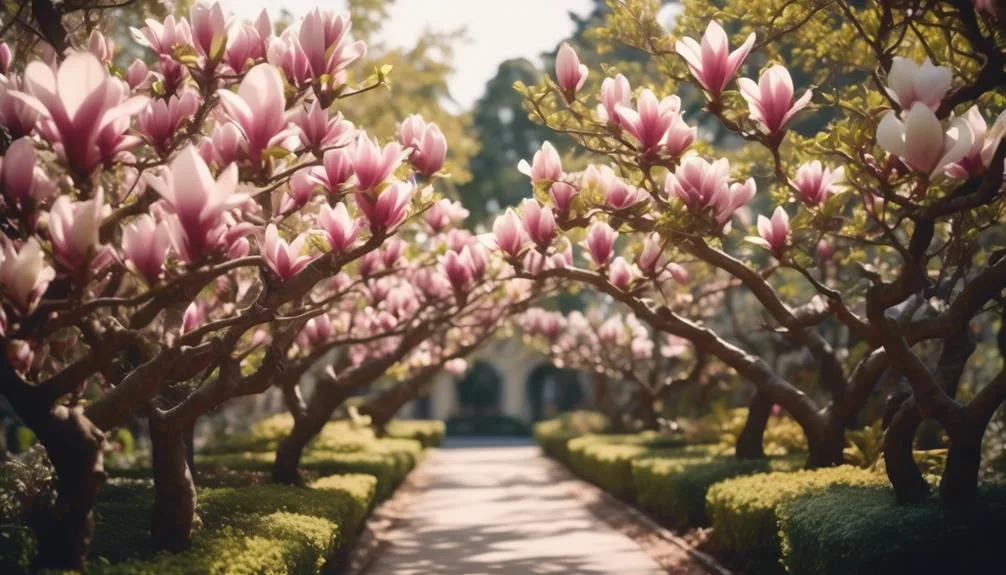Choosing the right magnolia for your climate is key to a thriving garden. Not all varieties can handle every weather condition – it's a common misconception. Whether you deal with harsh winters, scorching summers, or a mix of both, finding the perfect magnolia is essential.
Understanding your climate zones and assessing magnolia hardiness are crucial steps in this process. Let's explore how to make the best choice for your landscape.
Understanding Your Climate Zones
Do you know which climate zone you live in and how it affects the growth of magnolia trees?
Understanding your climate zone is crucial for successfully planting and nurturing magnolia trees. Different varieties of magnolia thrive in different climate zones, so it's important to choose the right one for your specific area.
Climate adaptation is key when it comes to magnolia trees. Some varieties are more tolerant of cold temperatures, while others thrive in warmer, more tropical climates.
Understanding your climate zone will help you determine the best planting strategies for your magnolia trees. By considering factors such as temperature, rainfall, and sunlight, you can ensure that your magnolia trees will adapt and flourish in your specific climate.
Assessing Magnolia Hardiness
Assessing the hardiness of magnolia trees is essential for determining their ability to withstand the specific climate conditions in your area. When evaluating hardiness, consider the average temperatures, humidity levels, and precipitation patterns in your region.
Magnolias are generally adaptable, but some varieties are better suited for certain climates. For example, if you live in a colder climate, you'll want to choose a magnolia variety known for its cold hardiness. On the other hand, if you reside in a warmer region, you should look for a magnolia that can thrive in higher temperatures.
Understanding these climate considerations will help you select a magnolia variety that can flourish in your specific environment, ensuring that your tree has the best chance of thriving and beautifying your landscape.
Selecting Magnolia Varieties for Cold Climates
When selecting magnolia varieties for cold climates, consider their tolerance to low temperatures and adaptability to winter conditions. Look for frost-resistant magnolias that can withstand harsh freezing temperatures. Here are some key considerations for choosing magnolia varieties in cold climates:
- Cold hardiness: Opt for magnolia varieties known for their ability to thrive in cold climates. Look for species such as Magnolia stellata and Magnolia kobus, which are renowned for their cold tolerance.
- Late blooming: Select magnolia varieties that bloom later in the spring to avoid damage from late frosts.
- Evergreen options: Consider evergreen magnolia varieties that can maintain their foliage during the winter, providing year-round interest in colder climates.
- Sheltered planting locations: When growing magnolias in cold climates, consider planting them in protected or sheltered areas to shield them from harsh winter winds and extreme cold.
Choosing the right magnolia variety for your cold climate ensures a beautiful and thriving garden even in challenging winter conditions.
Choosing Magnolia Varieties for Warm Climates
When selecting magnolia varieties for warm climates, ensure that the chosen species can thrive in high temperatures and adapt to the demands of a hot environment. Look for magnolia varieties that prefer well-drained, slightly acidic soil with a pH range of 5.0 to 6.5.
Additionally, consider selecting species that can handle full sunlight exposure, as warm climates often come with intense sunlight. Some magnolia varieties suitable for warm climates include the Little Gem, Southern Charm, and Jane magnolias. These varieties are known for their heat tolerance and can thrive in the warmer regions.
When planting magnolias in warm climates, ensure that the soil is rich in organic matter and mulch around the base of the plant to retain moisture, as the hot climate can lead to quicker evaporation.
Tips for Maintaining Magnolias in Your Climate
To ensure that your chosen magnolia variety continues to thrive in your warm climate, it's essential to employ effective maintenance strategies that support the plant's specific needs and ensure its long-term health and beauty. Here are some tips for maintaining magnolias in your climate:
- Pruning Techniques: Regularly prune your magnolia to remove dead or damaged branches and shape the tree. Pruning should be done in late winter or early spring to avoid interfering with the flowering season.
- Soil Requirements: Ensure that the soil is well-draining to prevent waterlogging, which can lead to root rot. Consider adding organic matter to improve soil structure and fertility.
- Mulching: Apply a layer of organic mulch around the base of the magnolia to retain moisture and regulate soil temperature.
- Watering: Provide consistent watering, especially during the establishment phase, to help the magnolia develop a strong root system.
Conclusion
With the right magnolia variety, your garden can flourish in any climate. Consider the hardiness, bloom time, and maintenance needs to ensure a successful addition to your landscape.
Happy planting, and may your garden bloom beautifully in harmony with your climate.

My interest in trees started when I first saw the giant sequoias in Yosemite.
I was a teenager then, and I remember thinking, “I need to learn more about this.”
That moment stuck with me.
A few years later, I went on to study forestry at Michigan Tech.
Since graduating, I’ve worked in a mix of hands-on tree care and community education.
I’ve spent over ten years helping people understand how to plant, maintain, and protect the trees in their neighborhoods.
I don’t see trees as just part of the landscape.
They are living things that make a real difference in our daily lives.
